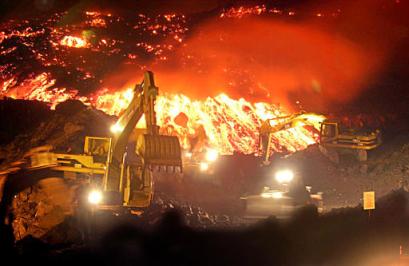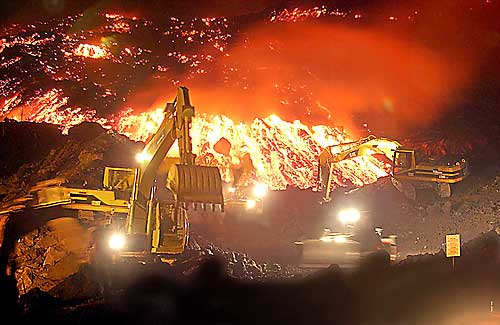
|
|
|
What's IotD? The interesting, amazing, or mind-boggling images of our days. |
|
IotD Stuff |
|
Permalink Latest Image |
|
|
|
Some folks who have noticed IotD
Neatorama |
|
Common image haunts
Astro Pic of the Day |
|
Advertising |
11/25/2002: Etna dig

Griff knows I like volcano pictures and man vs. nature pictures, and so he has sent along an excellent example of both.
These fellows are appantly trying to divert lava from Mt. Etna. The earth itself has burped up molten rock at 4000 degrees, and it slowly trickles its way down to where you are, killing everything in its path. You have to re-direct it at the very last minute. Good luck.
jeni Monday Nov 25 04:03 PM
scary that there are so many things on this earth that can kill you. scary that there are tiny things you can't see, and then there are these huge things that can spew scalding hot stuff out and burn you to death. and you can see those, but you don't really know if they are going to go off at any given second. weird. to me, anyway.
Griff Monday Nov 25 04:33 PM
This photo really spoke to the tool wielding primate in me. Perched on the brink of oblivion these folks are using the machinery at hand. Its raw emotion and power. Add in the glare effects from the lights and lava and the blur of motion from the whirling Cats and it's just a great photo. The activity is no less primitive than some monkey trying to ease termites onto a stick, these guys are overmatched and they know it but with a little finesse, they might just pull it off.
xoxoxoBruce Monday Nov 25 05:07 PM
The only reason we survive at all is that mother nature
usually moves slowly. When she moves, getting to hell out
the way is your only option.
Tobiasly Monday Nov 25 05:40 PM
I'd like a bigger version of this photo (although I'm sure if you knew where one was you would have posted that.)
It's hard to tell the perspective of the equipment vs. volcano here. But I guess that's part of what makes it a very cool photo.
Bitman Monday Nov 25 06:49 PM
|
Originally posted by jeni and then there are these huge things that can spew scalding hot stuff out and burn you to death. |
dasviper Monday Nov 25 09:11 PM
Man v. Pele
Read John McPhee's The Control of Nature for a fascinating account of a small town in Iceland (redundant?) which had to divert the flow of a volcano to avoid their harbor being sealed off. Rather than backhoes, they used gallons upon gallons of seawater. Here are a couple of illustrative photos.


perth Tuesday Nov 26 12:14 AM
dasviper, that second pic is friggin awesome. thanks!
~james
mrputter Tuesday Nov 26 10:32 AM
Best IOTD Ever
I think the subject says it all.
I've been around the IOTD for a long time (although primarily as a lurker), and this is hands down, the best one to date.
Thanks, Undertoad! You made my day.
helen Tuesday Nov 26 10:46 AM
This is almost surreal. If we didn't really know it was actually happening we might think it was the latest Sci-Fi flick from James Cameron.
Undertoad Tuesday Nov 26 11:42 AM
Thank Griff for this one, and dasviper for the excellent followup images.
Griff Tuesday Nov 26 03:39 PM
A slightly larger version can be found at the Seattle Times. Its an AP photo by Villa Fabrizio so if anyone knows where to look...
Undertoad Tuesday Nov 26 05:00 PM
Nic sends along a bigger version:

juju Tuesday Nov 26 07:14 PM
All this talk of volcanoes reminds me of a Geology class I had a couple semesters ago. The teacher touched on something I thought was really cool: How do scientists <b>know</b> that the Earth's core is liquid? After all, they can't get to the center of the Earth. Are they just guessing or something?
Well, of the various kinds of seismic waves, there are two main types that travel outward in all directions from the center of an earthquake: Primary waves and secondary waves. Because of the way they vibrate, primary waves can travel through liquid. Secondary waves cannot. So, scientists set up seismograph stations in several different countries all over the globe, and wait for an earthquake to occur. When one does, they see which stations received which kinds of waves from the 'quake. The results look something like this:


As you can see, the primary waves from an earthquake can be detected on the other side of the earth, but the secondary waves can't. They never get through. Therefore, the earth must have a liquid core.
The above linked site also talks about the distortion that's found in the Primary wave results (called 'P waves' here):
<blockquote> In contrast, the P waves are detected on the opposite side of the Earth as the focus. A shadow zone from 103° to 142° does exist from P waves, though. (Plummer and McGeary 381, 382) Since waves are detected, then not, then reappear again, something inside the Earth must be bending the P waves and bending them towards the normal. From this evidence using waves, we can tell that part of the core is liquid (S wave shadow) and part (the inner part) must be solid with a different density than the rest of the surrounding material (P wave shadow zone due to refraction). In actuality, the inner core is thought to be made of solid iron and nickel. </blockquote>
Isn't that cool?
Tobiasly Wednesday Nov 27 12:16 PM
That is pretty cool. Technology is awesome. I'm guessing they could then, based on that data, make a pretty decent estimate of the actual size of the liquid core.
juju Wednesday Nov 27 01:56 PM
I also neglected to mention that when seismic waves go through a material that is a different density than the one it was traveling through before, it refracts the waves, sort of like water refracts light. So that's how they know what the different layers of the Earth are like. Somehow they can calculate the angle of the refraction and figure the density of the new kind of rock.
Also, this same technology is used for detecting oil deposits.
|
Your reply here?
The Cellar Image of the Day is just a section of a larger web community: a bunch of interesting folks talking about everything. Add your two cents to IotD by joining the Cellar. |